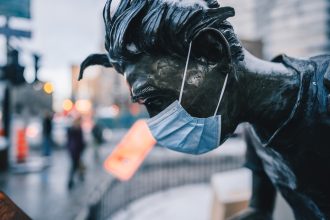Every year, a new budget must be created to allocate funds for the upcoming fiscal year, which began on October 1st, 2025. Since that date, the United States government has been experiencing a government shutdown, which occurs when the Democratic and Republican parties are unable to agree on a budget. The government is shut down when the parties are unable to set a budget because there is no agreed-upon system for the allocation of government funding, causing government services to stop operating. In order to avoid a shutdown, Congress will attempt to pass a temporary spending bill to fund the government for a certain period of time. But, in order to pass a temporary spending bill, there must be at least 60-votes cast in favor of it. The new bill has failed to reach this threshold fourteen times since October 1st. Republicans control both the House of Representatives and the Senate, with the Republicans currently holding 53 seats in the Senate and 219 seats in the House, but they are unable to convince Democrats to vote with them, and Democrats are unable to influence Republicans to agree to Democratic ideals, causing them to be unable to reach the 60-vote threshold. During a government shutdown, many ‘nonessential’ public services are suspended, such as museums and parks. However, necessary services such as border protection, law enforcement, air traffic control, and social security are still operated simply without paying the workers.
Due to this, roughly 40 percent of the workforce, or 750,000 individuals, are left without compensation.
There may also be delays in tax refunds, small business loans, and housing assistance. The Coast Guard and the Military are said to be receiving paychecks soon, although the source of these payments is unclear.
The last government shutdown was in January and December of 2019 and lasted 35 days. It was the longest government shutdown to date and was due to ongoing disputes over Trump’s Mexican border policy during his first term. Other significant government shutdowns include the 21-day shutdown during Bill Clinton’s administration and the 16-day shutdown during Barack Obama’s administration due to the Affordable Care Act (ACA). This government shutdown has been one of the longest ones yet, which may be due to the fact that President Donald Trump has reduced the size of the national government. This can lead to more programs relying on annual congressional funding instead of automated services and those in the government using the shutdown to pressure others in the government to cut spending and limit taxation.
This government shutdown could resolve within days, as a bipartisan spending bill has been approved in the Senate and is up for vote in the house. With Republicans seemingly unwilling to concede on certain points of contention, we see that Democrats have given in to prevent the government shutdown from being even more disruptive. Some important points of this government shutdown include the budget allocation for ACA and Medicaid. Democrats want to continue having substantial funding for the ACA and Medicaid programs, while Republicans are standing firm in their desire to limit funding to such programs.
How do Voters feel? Voters blame Republicans more than Democrats for the current shutdown. 41% of voters blame the Grand Old Party (GOP), while 30% blame the Democratic Party. 30% blame both parties equally. Interestingly, Republican voters blame the Democrats in Congress for the shutdown continuing to occur, and Democratic voters blame Donald Trump. But these same voters stated that they trust the GOP more with economic issues.
“The bottom line is Americans are being hurt… and somebody needs to do something to be the grown-up in the group,”
The majority of Americans, regardless of party affiliations, are highly concerned with the shutdown, and many citizens are worried about the delay or suspension of aid programs that they rely on.
Although there may be an end in sight, the shutdown has left many workers unpaid, caused major delays across agencies, and suspended many government-funded programs. Air travel from the United States is slowed and limited, and additionally, the process of receiving passports and visas is also slowed down during such times. There may be a downturn in the purchasing of services and goods, leading to a decrease in the overall GDP for this quarter of the fiscal year. This drop may impact the global market, with this negative impact set to increase as the government shutdown continues. American allies may also experience delays in joint military or humanitarian projects that receive funding from the United States. Additionally, this government shutdown has been an overall detriment for individuals wanting to apply to government positions in the future, and the shutdown may also be taking an emotional toll on the workers and their families who might be living paycheck to paycheck due to the lack of funds, causing the morale among these workers to be low during this time. In conjunction, officials have threatened to identify those who are nonessential workers and to lay off many people.
With a spending bill now awaiting approval in the House of Representatives, the government shutdown appears to be nearing a close. However, its political, economic, and human costs will linger in the minds of Americans long after the doors of federal offices reopen.








